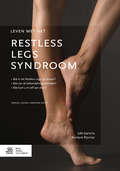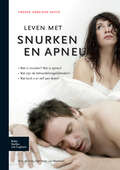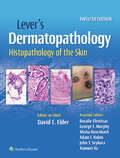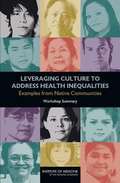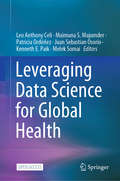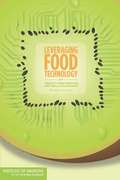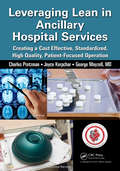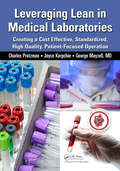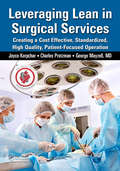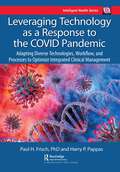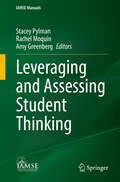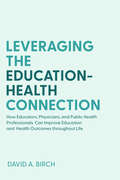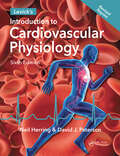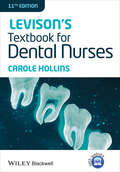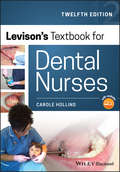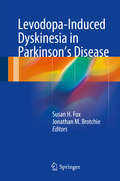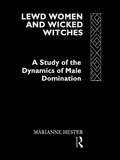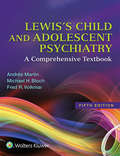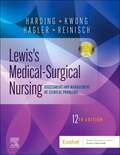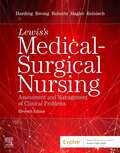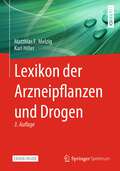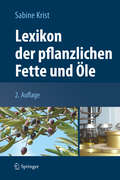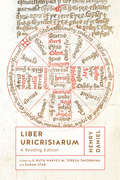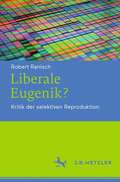- Table View
- List View
Leven met het restless legs syndroom
by Joke Jaarsma Roselyne M. Rijsman"In dit boek komen de diverse aspecten van RLS aan de orde. Wat is de oorzaak, hoe stel je de diagnose, hoe vaak en bij wie komt het voor, kan RLS behandeld of genezen worden, wat kun je in eerste instantie zelf doen, wat betekent het voor je omgeving? Duidelijk is dat RLS niet alleen het leven van de patiënt zelf ingrijpend kan verstoren, maar ook dat van de naaste omgeving. Het boek biedt dan ook handvatten om de kwaliteit van leven te verbeteren." Naast het informeren van patiënten over RLS is dit boek ook geschreven om behandelaars en begeleiders informatie te bieden waarmee zij hun behandeling en benadering van de patiënt kunnen optimaliseren.
Leven met snurken en apneu
by Piet Heijn Mechelen Nico De VriesNieuwe herziene editie van Leven met snurken. Geheel geactualiseerd en aangevuld met de nieuwste ontwikkelingen.
Lever's Dermatopathology: Histopathology of the Skin
by Misha Rosenbach Adam I. Rubin David E. Elder Rosalie Elenitsas George F. Murphy John T. Seykora Xiaowei XuUsed by generations of physicians who encounter patients with dermatological diseases, Lever’s Dermatopathology: Histopathology of the Skin comprehensively covers skin disease in which histopathology plays an important role in diagnosis. The updated 12th Edition, edited by Drs. David E. Elder, Rosalie Elenitsas, George F. Murphy, Misha Rosenbach, Adam I. Rubin, John T. Seykora, and Xiaowei Xu, maintains the proven, clinicopathologic classification of cutaneous disease while incorporating a “primer” on pattern-algorithm diagnosis. It features larger images throughout, as well as thoroughly revised content with new diseases and new information on pathophysiology and molecular pathogenesis—all in an easy-to-navigate, highly readable format.
Leveraging Culture to Address Health Inequalities
by Institute of Medicine Steve Olson Karen M. Anderson Board on Population Health and Public Health Practice Roundtable on the Promotion of Health Equity and the Elimination of Health DisparitiesLeveraging Culture to Address Health Inequalities: Examples from Native Communities is the summary of a workshop convened in November 2012 by the Roundtable on the Promotion of Health Equity and the Elimination of Health Disparities of the Institute of Medicine. The workshop brought together more than 100 health care providers, policy makers, program administrators, researchers, and Native advocates to discuss the sizable health inequities affecting Native American, Alaska Native, First Nation, and Pacific Islander populations and the potential role of culture in helping to reduce those inequities. This report summarizes the presentations and discussion of the workshop and includes case studies that examine programs aimed at diabetes prevention and management and cancer prevention and treatment programs. In Native American tradition, the medicine wheel encompasses four different components of health: physical, emotional, mental, and spiritual. Health and well-being require balance within and among all four components. Thus, whether someone remains healthy depends as much on what happens around that person as on what happens within. Leveraging Culture to Address Health Inequalities addresses the broad role of culture in contributing to and ameliorating health inequities.
Leveraging Data Science for Global Health
by Maimuna S. Majumder Leo Anthony Celi Patricia Ordóñez Juan Sebastian Osorio Kenneth E. Paik Melek SomaiThis open access book explores ways to leverage information technology and machine learning to combat disease and promote health, especially in resource-constrained settings. It focuses on digital disease surveillance through the application of machine learning to non-traditional data sources. Developing countries are uniquely prone to large-scale emerging infectious disease outbreaks due to disruption of ecosystems, civil unrest, and poor healthcare infrastructure – and without comprehensive surveillance, delays in outbreak identification, resource deployment, and case management can be catastrophic. In combination with context-informed analytics, students will learn how non-traditional digital disease data sources – including news media, social media, Google Trends, and Google Street View – can fill critical knowledge gaps and help inform on-the-ground decision-making when formal surveillance systems are insufficient.
Leveraging Food Technology for Obesity Prevention and Reduction Effort: Workshop Summary
by The National Academy of SciencesObesity is a major public health challenge. More than one-third of the U. S. adult population is considered obese, a figure that has more than doubled since the mid-1970s. Among children, obesity rates have more than tripled over the same period. Not only is obesity associated with numerous medical complications, but it incurs significant economic cost. At its simplest, obesity is a result of an energy imbalance, with obese (and overweight) people consuming more energy (calories) than they are expending. During the last 10-20 years, behavioral scientists have made significant progress toward building an evidence base for understanding what drives energy imbalance in overweight and obese individuals. Meanwhile, food scientists have been tapping into this growing evidence base to improve existing technologies and create new technologies that can be applied to alter the food supply in ways that reduce the obesity burden on the American population. Leveraging Food Technology for Obesity Prevention and Reduction Effort examines the complexity of human eating behavior and explores ways in which the food industry can continue to leverage modern food processing technologies to influence energy intake. The report also examines the opportunities and challenges of altering the food supply--both at home and outside the home--and outlines lessons learned, best practices, and next steps.
Leveraging Lean in Ancillary Hospital Services: Creating a Cost Effective, Standardized, High Quality, Patient-Focused Operation
by Charles Protzman Joyce Kerpchar George MayzellThis book is part of a series of titles that are a spin-off of the Shingo Prize-winning book Leveraging Lean in Healthcare: Transforming Your Enterprise into a High Quality Patient Care Delivery System. Each book in the series focuses on a specific aspect of healthcare that has demonstrated significant process and quality improvements after a Lean
Leveraging Lean in Medical Laboratories: Creating a Cost Effective, Standardized, High Quality, Patient-Focused Operation
by Charles Protzman Joyce Kerpchar George MayzellThis book is part of a series of titles that are a spin-off of the Shingo Prize-winning book Leveraging Lean in Healthcare: Transforming Your Enterprise into a High Quality Patient Care Delivery System. Each book in the series focuses on a specific aspect of healthcare that has demonstrated significant process and quality improvements after a Lean
Leveraging Lean in Surgical Services: Creating a Cost Effective, Standardized, High Quality, Patient-Focused Operation
by Charles Protzman Joyce Kerpchar George MayzellThis book is part of a series of titles that are a spin-off of the Shingo Prize-winning book Leveraging Lean in Healthcare: Transforming Your Enterprise into a High Quality Patient Care Delivery System. Each book in the series focuses on a specific aspect of healthcare that has demonstrated significant process and quality improvements after a Lean
Leveraging Lean in the Emergency Department: Creating a Cost Effective, Standardized, High Quality, Patient-Focused Operation
by Charles Protzman Joyce Kerpchar George MayzellThis book is part of a series of titles that are a spin-off of the Shingo Prize-winning book Leveraging Lean in Healthcare: Transforming Your Enterprise into a High Quality Patient Care Delivery System. Each book in the series focuses on a specific aspect of healthcare that has demonstrated significant process and quality improvements after a Lean
Leveraging Technology as a Response to the COVID Pandemic: Adapting Diverse Technologies, Workflow, and Processes to Optimize Integrated Clinical Management (Intelligent Health Series)
by Harry P. Pappas Paul H. FrischIn 2019 the world was struck with the Coronavirus (COVID-19) infecting major portions of the world’s population. There were no vaccines or treatments available to help mitigate the disease or offer a cure. The world's health systems were inundated with massive numbers of patients with varying ranges of symptoms, acuity, and levels of criticality. The world's healthcare organizations soon found themselves in an unmanageable situation, directly impacting the ability to manage patients across the entire healthcare environment. Most healthcare institutions had plans for emergency preparedness and procedures to deal with temporary crises, none of which were effective against the impact of COVID-19. COVID-19 was a highly contagious disease, resulting in high volumes of admissions with long lengths of stay. The virus quickly overwhelmed institutions with large patient volumes, resulting in shortages of patient beds, medical equipment, personal protective devices, cleaning agents, and other critical supplies. Hospital operations were further impacted by staff shortages due to exposure, resulting contagion, the shutdown of transit systems, and responsibilities at home due to school and business closures. This timely and important book describes the impact on the hospital ability to provide patient care and how healthcare institutions leveraged diverse technology solutions to combat the impact of COVID-19 on providing patient care. The authors also discuss implementation of these technology solutions and the many lessons learned of how healthcare institutions can enhance their emergency preparedness in the future from the COVID experience. The authors would like to acknowledge, thank, and dedicate this book to the hundreds of thousands of healthcare workers around the world who spent countless hours and put their own lives and families lives at risk to help patients though this pandemic.
Leveraging and Assessing Student Thinking (IAMSE Manuals)
by Amy Greenberg Stacey Pylman Rachel MoquinThis book is a compilation of teaching theories and strategies for eliciting and interpreting student thinking to adapt to educational settings. Medical education is no longer about simply providing students with knowledge, as it was in Flexner’s day. Modern medical education is focused on shaping how students understand, define, and move the practice of medicine forward. Modern medical schools focus on building student’s ability to reason clinically and develop their own identity as professionals while integrating those pieces of their identity with their emerging content knowledge. This level of high-quality education requires medical educators to understand their learners and see their learners as more than repositories for knowledge. A medical educator must understand who the learner is, what the learner already knows, and what misunderstandings the learner has. Hence, educators must learn to be skilled not simply at conveying information, but rather at eliciting student thinking and understanding to discern what and how to best teach the learner. Faculty often think of teaching this way as complex and time-consuming. However, in this manual we reveal that once the theoretical underpinnings of why leveraging and assessing student thinking matters are understood, educators can enact the theory by building specific teaching skills. This manual is written by authors steeped in educational theory and with a background in teacher education. Other manuals and book chapters have looked at active learning and rubrics which are part of learner-centered instruction. This manual is the first of its kind to help medical educators practice what it means to teach in a learner-centered way by leveraging student thinking. The manual is written using educational theory and literature, includes vignettes for illustrative purpose, and provides practical steps in enacting strategies to elicit student thinking. In the first section of this manual, we define the practices of eliciting and interpreting student thinking and explain why student thinking matters, introduce readers to gradual release theories of learning, and showcase the benefits of using students’ experiences, background, and prior knowledge. In the second section of the manual, we explain in further detail how to leverage and assess student thinking. We describe, illustrate with vignettes, and provide step by step guides on the skills of questioning, giving feedback, debriefing clinical experiences, analyzing student work, and assessing student thinking and understanding in the medical education context.
Leveraging the Education-Health Connection: How Educators, Physicians, And Public Health Professionals Can Improve Education And Health Outcomes Throughout Life
by David A. BirchLevick's Introduction to Cardiovascular Physiology
by Neil Herring David J. PatersonA sound knowledge of cardiovascular physiology is fundamental to understanding cardiovascular disease, exercise performance and may other aspects of human physiology. Cardiovascular physiology is a major component of all undergraduate courses in physiology, biomedical science and medicine, and this popular introduction to the subject is intended primarily for these students. A key feature of this sixth edition is how state-of-the-art technology is applied to understanding cardiovascular function in health and disease. Thus the text is also well suited to graduate study programmes in medicine and physiological sciences.
Levison's Textbook for Dental Nurses
by Carole HollinsIn this brand-new 11th edition of the original, best-selling book, Levison's Textbook for Dental Nurses gives you the same great comprehensive coverage of everything students preparing for their dental nurse qualification need to know, and also includes for the first time:A new look and feel, packed with illustrations and diagrams to make visual learning easyKey Learning Points in every chapter help you master essential informationAn accompanying website designed to help you test your knowledge with self-assessment exercises, case-studies and downloadable imagesFully in line with the most recent developments in dental nursing practice and education, Levison's Textbook for Dental Nurses is the only dental nursing book written specifically to cater to the new NEBDN Diploma in Dental Nursing.Written by Carole Hollins, the former Chair of the National Examining Board for Dental Nurses, the new edition of Levison's classic textbook is the only companion you need to get you through to qualification as a successful and accomplished dental nurse.
Levison's Textbook for Dental Nurses
by Carole HollinsA fully updated edition of the best-selling textbook for students studying for their dental nurse qualification Levison’s Textbook for Dental Nurses continues to be an indispensable resource written specifically for those undertaking the NEBDN National Diploma in Dental Nursing. This new edition provides in-depth coverage in many areas, such as the structure of the dental profession; an update of the current, available NHS dental services; information on extended duties for dental nurses; legal and ethical issues; health and safety including COSHH and waste disposal legislation updates; general anatomy and physiology; and medical emergencies. New edition of a classic textbook, fully in line with the most recent developments in dental nursing practice and education Caters especially for the NEBDN National Diploma in Dental Nursing Outlines the latest GDC standards for dental nurses Key Learning Points in every chapter to help readers master essential information Packed with illustrations and diagrams to assist with aiding comprehension, this student-friendly text is ideal for dental nurses studying for the NEBDN National Diploma in Dental Nursing. It will also be of great benefit to dental nurses studying for the City & Guilds Diploma in Dental Nursing, Level 3.
Levodopa-Induced Dyskinesia in Parkinson's Disease
by Susan H. Fox Jonathan M. BrotchieThis book aims to provide a single reference source on levodopa-induced dyskinesias (LID) from 'bench to bedside'. Initial chapters review the clinical features and phenomenology of LID with video examples; epidemiology and genetic risk factors for LID are covered as a background to understanding risk factors for developing LID. The following chapters cover the latest preclinical studies aiming to understand the pathophysiology of LID at the cellular, neurochemical, neurophysiological and circuitry level with detailed discussion of mechanisms and future directions to take the field forward; clinical studies from phase II to phase IV; on going RCTs in LID and evidence-based medicine reviews of treatment options. Levodopa-Induced Dyskinesia in Parkinson's Disease is aimed at an international audience of movement disorder neurologists; neuroscientists; trainees and graduate and post-graduate students.
Lewd Women and Wicked Witches: A Study of the Dynamics of Male Domination
by Marianne HesterIn the sixteenth century and seventeenth centuries it was women who were almost exclusively persecuted as witches. However, the witch craze has been subjected to surprisingly little feminist analysis. In Lewd Women and Wicked Witches, Marianne Hester reviews and develops revolutionary feminist thinking. Accordingly, she shows how witches can be seen as victims of the oppression of a male dominated society.Concentrating on English source material, the author shows how witch-hunts may be seen as an historically specific example of male dominance. Relying on an eroticised construct of women's inferiority, they were part of the ongoing attempt by men to maintain their power over women.
Lewis's Child and Adolescent Psychiatry: A Comprehensive Textbook
by Fred R. Volkmar Andrés Martin Michael H. BlochFor 25 years, Lewis's Child and Adolescent Psychiatry has been the cornerstone of every child and adolescent psychiatrist’s library. Now, three colleagues of Dr. Lewis at the world-renowned Yale Child Study Center, have substantially updated and revised this foundational textbook for its long-awaited fifth edition, the first in ten years. Encyclopedic in scope, it continues to serve as a broad reference, deftly encompassing and integrating scientific principles, research methodologies, and everyday clinical care.
Lewis's Medical-Surgical Nursing: Assessment and Management of Clinical Problems, Single Volume
by Debra Harding Mariann Kwong Jeffrey HaglerGain the knowledge and skills you need to succeed in medical-surgical nursing with this leading textbook! Lewis's Medical-Surgical Nursing, 12th Edition uses a conversational writing style, a focus on nursing concepts and clinical trends, evidence-based content, and basic pathophysiology review to provide the solid foundation needed in a rapidly changing healthcare environment. Comprehensive chapters cover topics including nursing management and collaboration, health promotion, acute interventions, and ambulatory care. Summary tables and boxes make it easy to find essential information, and a building-block approach makes even the most complex concepts simple to grasp. In addition to three new chapters, this edition includes a stronger focus on the nursing process, clinical judgment, and preparation for the Next-Generation NCLEX® Examination.
Lewis's Medical-surgical Nursing: Assessment And Management Of Clinical Problems, Single Volume
by Mariann M. Harding Jeffrey Kwong Dottie Roberts Debra Hagler Courtney ReinischLewis’s Medical-Surgical Nursing, 11th Edition gives you a solid foundation in medical-surgical nursing. This thoroughly revised text includes a more conversational writing style, an increased focus on nursing concepts and clinical trends, strong evidence-based content, and an essential pathophysiology review. Content covers all aspects of nursing care including health promotion, acute intervention, and ambulatory care. Helpful boxes and tables make it easy for you to find essential information, and a building-block approach makes even the most complex concepts simple to grasp. Key topics such as interprofessional care, delegation, safety, and prioritization are integrated throughout. Additionally, extensive drug therapy information and diagnostic studies tables give you a full picture of care. Best of all ― a complete collection of learning and study resources helps you learn more effectively and offers valuable, real-world preparation for clinical practice.
Lexikon der Arzneipflanzen und Drogen
by Matthias F. Melzig Karl HillerDas Lexikon der Arzneipflanzen und Drogen gibt einen umfassenden Überblick über die heute wie auch in früherer Zeit verwendeten Arzneidrogen. Die 3. Auflage des Lexikons enthält ca. 480 neue Artikel inkl. Strukturformeln der Drogeninhaltsstoffe und wurde um das Gebiet der Nahrungsergänzungsmittel erweitert. In den einzelnen Artikeln wird auf Drogen europäischer Arzneibücher hingewiesen sowie auf solche, die in der europäischen, afrikanischen, amerikanischen oder asiatischen traditionellen Medizin eingesetzt werden. Die Anordnung der Stichwörter erfolgt alphabetisch nach den wissenschaftlichen Namen der Pflanzen/Tiere/Mikroorganismen und beinhaltet Vorkommen bzw. Herkunft der Drogen, Inhaltsstoffe, therapeutische Nutzung bzw. Anwendung in der Volksheilkunde und Homöopathie. Als umfassendes Nachschlagewerk für alle Fragestellungen zu Arzneidrogen wendet sich das Lexikon an Wissenschaftler und Studenten der Pharmazie, Biologie, Medizin, Chemie sowie an Ärzte für Naturheilverfahren, Apotheker, Heilpraktiker und an Mitarbeiter in der Industrie.
Lexikon der pflanzlichen Fette und Öle
by Sabine KristAus naturwissenschaftlicher Sicht stellen die Autoren 135 bekannte und exotische Pflanzenöle, Wachse und pflanzliche Fette systematisch dar - darunter Kiwisamen-, Tomatenkern- und Ootangaöl. Besonderes Augenmerk gilt den Stammpflanzen, der Gewinnung, den Inhaltsstoffen sowie der ernährungsphysiologischen Zusammensetzung. Anwendungsmöglichkeiten in Medizin, Pharmazie, Kosmetik und Technik sowie mögliche Nebenwirkungen werden diskutiert. In die Neuauflage des Lexikons wurden 40 weitere Fette und Öle aufgenommen.
Liber Uricrisiarum: A Reading Edition
by Henry DanielHenry Daniel’s Liber Uricrisiarum is the earliest known work of academic medicine written in Middle English, presented here for the first time in a complete edition. Working in the late 1370s, Daniel combined authoritative medicine from written sources with his own personal experience, creating a text that stands out for its linguistic originality, intellectual scope, and wide circulation. Extant in over three dozen manuscript witnesses and two early modern print copies, Liber Uricrisiarum describes medieval humoral theory, anatomy, physiology, disease, medical astronomy, reproductive processes, and more, all within the broader context of uroscopic diagnosis. The introduction situates the text and its author in their medical, intellectual, linguistic, and bibliographic contexts, outlining the uroscopic tradition to which Daniel contributes, and describing the relationships among the many manuscripts containing the Liber Uricrisiarum. This edition presents the Middle English text, with a general glossary, glossary of proper names, and explanatory notes that explain obscure words and phrases and identify Daniel’s sources. It also includes the complete set of diagrams contained in the Royal manuscript; appendices providing the Latin and English versions of the prologue and epilogue; an extensive translation from one of Daniel’s important sources, Isaac Israeli’s De urinis; tables relevant to Daniel’s astronomical measurements; and an analysis of the Royal manuscript’s dialect. Cumulatively, the edition and apparatus introduce readers to an important yet understudied text, the details of which will have significant impact on studies of medieval medicine and science, intellectual history, and Middle English language and literature.
Liberale Eugenik?: Kritik der selektiven Reproduktion
by Robert RanischAnwendungen der Gendiagnostik und Reproduktionsmedizin erlauben es Wunscheltern, immer weiter auf das Erbgut ihrer Nachkommen Einfluss zu nehmen. Eine solche „liberale Eugenik“ wird mittlerweile auch in der Philosophie und Bioethik befürwortet. Wo liegen aber die Ursprünge eines solchen Denkens und wie ist eine umfassende Fortpflanzungsfreiheit zu bewerten? Ausgehend von einer freiheitlichen Ethik leistet die Studie eine immanente Kritik an der liberalen Eugenik und entwirft dabei eine eigene Position zum Umgang mit neuen gentechnischen Möglichkeiten.
